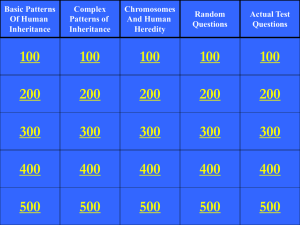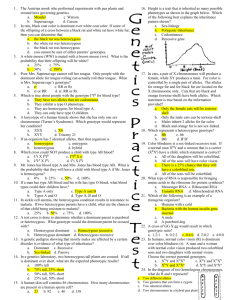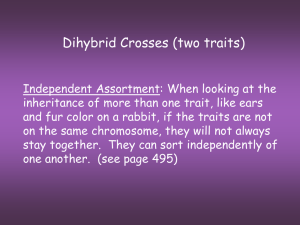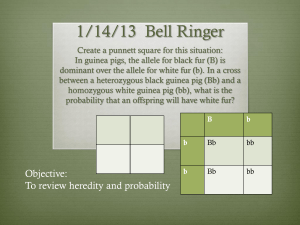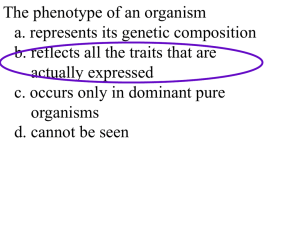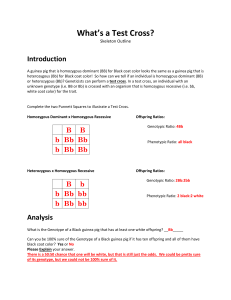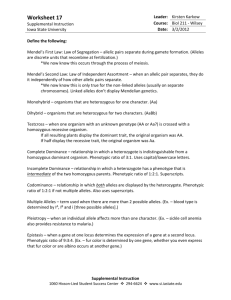Crosses Involving Two Traits
advertisement
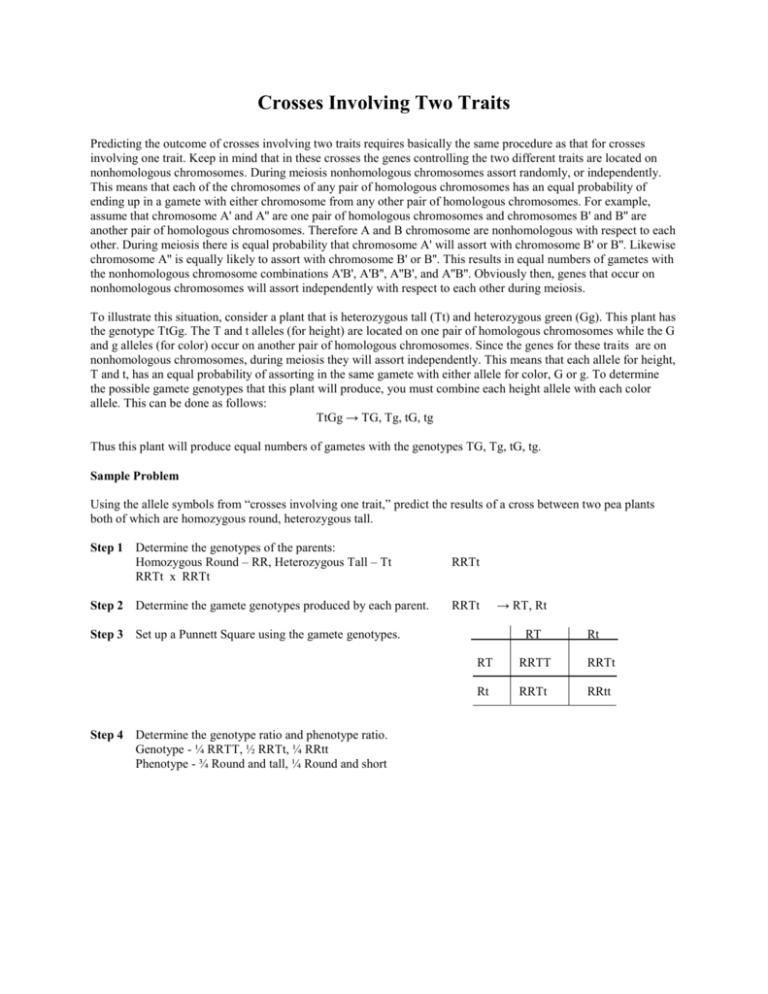
Crosses Involving Two Traits Predicting the outcome of crosses involving two traits requires basically the same procedure as that for crosses involving one trait. Keep in mind that in these crosses the genes controlling the two different traits are located on nonhomologous chromosomes. During meiosis nonhomologous chromosomes assort randomly, or independently. This means that each of the chromosomes of any pair of homologous chromosomes has an equal probability of ending up in a gamete with either chromosome from any other pair of homologous chromosomes. For example, assume that chromosome A' and A'' are one pair of homologous chromosomes and chromosomes B' and B'' are another pair of homologous chromosomes. Therefore A and B chromosome are nonhomologous with respect to each other. During meiosis there is equal probability that chromosome A' will assort with chromosome B' or B''. Likewise chromosome A'' is equally likely to assort with chromosome B' or B''. This results in equal numbers of gametes with the nonhomologous chromosome combinations A'B', A'B'', A''B', and A''B''. Obviously then, genes that occur on nonhomologous chromosomes will assort independently with respect to each other during meiosis. To illustrate this situation, consider a plant that is heterozygous tall (Tt) and heterozygous green (Gg). This plant has the genotype TtGg. The T and t alleles (for height) are located on one pair of homologous chromosomes while the G and g alleles (for color) occur on another pair of homologous chromosomes. Since the genes for these traits are on nonhomologous chromosomes, during meiosis they will assort independently. This means that each allele for height, T and t, has an equal probability of assorting in the same gamete with either allele for color, G or g. To determine the possible gamete genotypes that this plant will produce, you must combine each height allele with each color allele. This can be done as follows: TtGg → TG, Tg, tG, tg Thus this plant will produce equal numbers of gametes with the genotypes TG, Tg, tG, tg. Sample Problem Using the allele symbols from “crosses involving one trait,” predict the results of a cross between two pea plants both of which are homozygous round, heterozygous tall. Step 1 Determine the genotypes of the parents: Homozygous Round – RR, Heterozygous Tall – Tt RRTt x RRTt RRTt Step 2 Determine the gamete genotypes produced by each parent. RRTt Step 3 Set up a Punnett Square using the gamete genotypes. Step 4 Determine the genotype ratio and phenotype ratio. Genotype - ¼ RRTT, ½ RRTt, ¼ RRtt Phenotype - ¾ Round and tall, ¼ Round and short → RT, Rt RT Rt RT RRTT RRTt Rt RRTt RRtt Crosses Involving Two Traits Practice Problems For each exercise, (a) show the parental genotypes, (b) draw out the punnett square, and (c) determine the probable phenotype ratio, in the spaces provided. In mice, the ability to run normally is a dominant trait. Mice with this trait are called running mice (R). The recessive trait causes mice to run in circles only. Mice with this trait are called waltzing mice (r). Hair color is also inherited in mice. Black hair (B) is dominant over brown hair (b). 1. Cross a heterozygous running, heterozygous black mouse with a homozygous running, homozygous black mouse. a. ______________________ c. ______________________ b. 2. Cross a homozygous running, homozygous black mouse with a heterozygous running, brown mouse. a. ______________________ . c. ______________________ b. 3. Cross a waltzing, brown mouse with a waltzing, brown mouse. a. ______________________ c. ______________________ b. 4. Cross a homozygous running, heterozygous black mouse with a waltzing, brown mouse. a. ______________________ c. ______________________ b. 5. Cross a heterozygous running, brown mouse with a heterozygous running, homozygous black mouse. a. ______________________ c. ______________________ b. 6. Cross a heterozygous running, heterozygous black mouse with a heterozygous running, heterozygous, black mouse. a. ______________________ c. ______________________ b.
